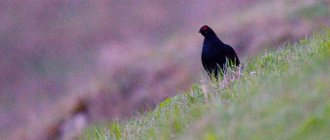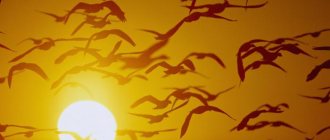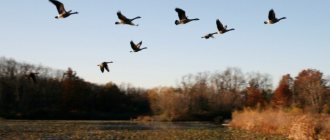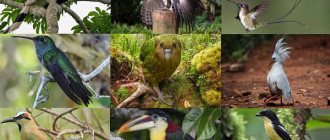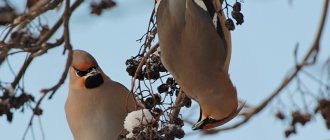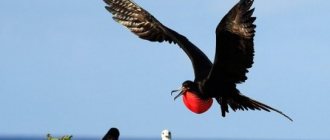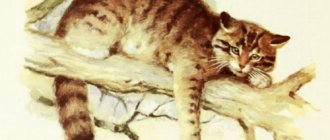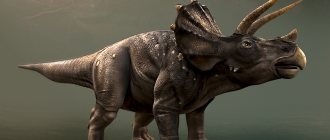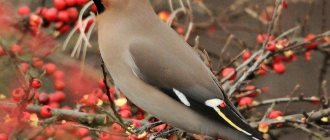The feathered inhabitants of the Tula region are quite diverse. As in other regions of Russia, part of the feathered fauna lives sedentary in these places; there are few such species. The rest nest and fly to warm countries for the winter, or are encountered on migration. But in every biotope, be it a forest, a pond, an open space or even an anthropogenic landscape, you can meet an interesting variety of birds and get acquainted with its external characteristics, lifestyle, habits and vocal characteristics.
Predator birds
Buzzard (Pernis apivorus)
Buzzard, common, or European, honeybuzzard / Pernis apivorus
Honey beetles are diurnal active predators that have an average size and a wingspan of up to 1.5 m. The species is rare, but can be found in the Tula region. Refers to migratory birds. The unusual name of the species is due to the fact that this feathered predator has an interesting habit of destroying wasp nests and feeding on insect larvae. By the way, honey beetles attack both bumblebees and wild bees with equal success. In addition, the diet includes amphibians, rodents and small birds. The honey beetle has a long tail and narrow wings. The feathers on the forehead look like scales. The upperparts are dark brown in color, the underparts are brown with light patterns or dark streaks. The wings are brown. The beak is dark. The paws are yellow. Read more about the bird here https://o-prirode.ru/osoed/
Steppe Harrier (Circus macrourus)
The length of the steppe harrier reaches 50 cm, its wingspan is about 60 cm. Females are slightly larger than males. Males have a light blue back with a dark shoulder body, cheeks and snow-white eyebrows. The belly is grayish or snow-white. The wings are gray, edged with white, and white on the inside. The tail is plain gray with a white edge. The beak is charcoal black. The paws are yellow. Females are distinguished by a brown back, variegated head color, the white edges of the color are replaced by red ones. The tail is gray-brown. The steppe harrier lives in open spaces, where it hunts small mammals - rodents and birds, which it searches for in low soaring flight above the surface of the earth.
Saker Falcon (Falco cherrug)
The saker falcon is a rare species of feathered predator, which in the Tula region leads a sedentary or nomadic lifestyle. For life, it usually chooses open spaces, where it is possible to hunt small mammals, amphibians and birds, while the saker falcon hunts the latter both on the surface of the earth and while flying in the air. Externally, the saker falcon is very similar to the gyrfalcon, differing from the latter in being slightly smaller in size. The weight of adult individuals is about 1 kg, body length up to 65 cm, wingspan about 1.5 m. Females are slightly larger than males. The plumage is gray with a reddish tint, darker above, lighter below, dark longitudinal streaks are located on the belly.
Rodents of the Bryansk region
Of the rodents, the river beaver is of particular value. This is a fairly large mammal. Its dense, muscular body, up to a meter long, tapers like a wedge to a small head. The front legs are tenacious and strong, well developed. The hind legs are twice as long as the front legs and have swimming membranes between the toes. The beaver's entire body is covered with dark chestnut or black fur, which is very beautiful, durable and valuable.
The beaver is a river animal. It lives in families in forest floodplains of rivers, near running water. Spends a lot of time in the water, swims and dives well. It feeds on various herbs, the bark of shrubs and trees, mainly aspen, willow, birch, bird cherry, and elm; It freely “cuts down” large trees with its sharp long front teeth, and then cuts them into small logs. Beavers eat small twigs and bark, but large sticks and logs remain in place or are used by them to build and repair their houses - huts, which always cause surprise to the observer who sees them for the first time. But even more surprising are the strong dams built by beavers, which raise water in small rivers sometimes to a height of up to one meter.
In the Bryansk region, river beavers live along the Iput, Besed and Gabya rivers. In order to further spread them, a batch of beavers was imported from the Voronezh-Bryansk region in 1947, and from Belarus in 1953. In addition, beavers were caught inside the Bryansk region and released for breeding into the Nerussa, Snezhet, Revna, Serizha and Navlya rivers. In all beaver breeding areas, reserves have been organized and hunting them is prohibited everywhere. As a result of the measures taken for protection and breeding, the beaver will soon become the master of our forest rivers and will bring great income to the national economy.
Songbirds
Wood lark (Lulllula arborea)
Wood lark, or spinning top / Lullula arborea
A singing inhabitant of the forests of the Tula region is the wood lark, also known as the spinning top. This small bird is painted a uniform brown color on top, which is decorated with dark longitudinal streaks. The bottom of the body is white with red, the same stripes on the sides of the tail and “eyebrow”. A crest is visible on the head. Unlike its relatives, the wood lark can often be seen sitting in a tree, from where it takes off vertically and sings its song in flight. The sonorous trills of this singer consist of the sounds “tuyu-lyululyu” and “lyulululyu”, “yuli-yuli” and “yul-yul”. And it makes a spiral flight, slowly flapping its wings and returning to its starting point. The woodlark's diet consists of insects and seeds.
Nightingale cricket (Locustella luscinioides)
The body length of the nightingale cricket is about 15 cm, weight reaches 25 g. The wide tail has a rounded shape. The color of the plumage is brown, monochromatic, there are no pronounced patterns or streaks on it, only a light, blurred “eyebrow” stands out on the head. The species is a migratory bird and nests in the Tula region near water bodies in bushy areas. Here he looks for his food, and the nightingale cricket feeds on insects. Unlike the common cricket, representatives of this species lead a rather open lifestyle and do not hide. The cry sounds like a short “tsik” or “piit” sound. The vocalization is deep and interesting, intertwining short chants with sounds such as “tik-tiktik-err”.
Aquatic warbler (Acrocephalus paludicola)
Aquatic Warbler / Acrocephalus paludicola
The Aquatic Warbler is an overall small species, but with a fairly wide overall distribution range throughout the world. This migratory bird, which winters in warm African countries, can be found during nesting almost throughout the entire territory of Eurasia. Its size is small, comparable to a tree sparrow. The wingspan is only 5 cm. The plumage on the back is brownish-green with dark patterns and rufous in the tail area. The brown head is decorated with two black stripes, between which there is a golden-green stripe. The belly is light reddish. The paws are yellow. The aquatic warbler lives in open spaces near ponds with thickets of bushes, from where its ringing, melodic, bright song can often be heard.
Siberian Crane
The bird is as tall as a human, and lives about the same. The oldest Siberian Crane was 80 years old. The wingspan of the bird is 2.5 meters. It looks impressive in the sky. There is a belief that flocks of Siberian Cranes are the souls of fallen soldiers. We are talking about white cranes.
Scientists call them Siberian Cranes. True, until three years of age the birds are red. White cranes, like swans, become sexually mature. Birds of the middle zone migrate in winter. However, in warm weather there is nowhere else for Siberian Cranes in Russia. The bird is recognized as endemic to the country and does not nest outside its borders.
In the photo the white crane Siberian Crane
Forest birds
Fifi (Tringa glareola)
Fifi / Tringa glareola
The plumage of a forest bird called fifi is made in black and white, and only on the back there are splashes of brown or brown color. The length of fifi is from 14 to 26 cm. Its appearance as a whole is not very specific; it is similar to fifi blackling and hermit snail, as well as herbalist. The easiest way to recognize a bird is during flight, since its legs are clearly visible behind the tail. This species of birds needs a forest area for nesting, since the bird builds its nests in hollows or occupies old abandoned nests of other bird species. The rest of the time, fifi is often found near water bodies, since its diet consists of insects and worms, as well as small mollusks that can be found in coastal mud.
Capercaillie (Tetrao urogallus)
In forests of all types of the Tula region, a representative of the pheasants is found, the largest of the grouse is the capercaillie. It differs from its closest relatives in its rounded tail and long feathers on the throat. The body length of males is about 1 m, the wingspan is 1.5 m, and their weight is up to 7 kg. The size of females is about a third smaller. The coloring of males and females of this species of birds is radically different. In the male, the head and neck area is jet black, the black back is decorated with brown and gray spots, the black craw shimmers with an emerald tint, and the belly is spotted with black and white spots. Chocolate colored wings. The black tail is decorated with snow-white spots. The eye ring is scarlet. The beak is pink. Females have a variegated coloration, consisting of red, black and white.
Great snipe (Gallinago media)
Great snipe / Gallinago media
The great snipe is a forest bird, as it nests in coniferous forests in clearings or edges. For the winter, these birds fly to Africa. At the same time, they are considered the fastest migratory birds, as they are capable of flying at a speed of about 100 km/h for more than 6,000 kilometers without stopping. This interesting feature was noticed only in the great snipe - it does not fall to the ground during a migratory flight, which is not typical for other species of migratory birds. The body length of the snipe reaches 30 cm, the wingspan is about 45 cm, the weight is up to 300 g. The body is dense, the beak is powerful and short. The color of the back is brown with dark streaks, the belly is light beige. A dark “mask” is visible on the eyes, and the dark wings are decorated with two snow-white stripes.
Birds of central Russian forests - how to see: tips and reviews
Nikolai : My son and I go out into nature at any free time. What I like most is visiting the forest. We go for berries and mushrooms. But we always carry a phone with us to photograph birds, and now we already have an impressive album with the birds we have seen. My son noticed long ago that they live completely differently in the forests. They do not beg for food, but are proud and luxurious. Want to see more birds? You see yourself in the forest quietly.
Lyudmila : A few years ago, my husband and I were offered a chic and cheap housing option, with one drawback. The outskirts of the village, and immediately the forest. But how my husband and I appreciated these quiet walks through the forest! No, we are not trying to catch birds either in a snare or through a lens. We walk almost silently through the forest, enjoying the singing of birds and their beauty. A year ago, we placed feeders and birdhouses along our favorite paths, thereby attracting and acclimating our favorite birds to the proximity. And in the fall we have a whole tradition of saying goodbye to flocks of birds flying south! And then we help the birds remaining for the winter to spend it well-fed and warm.
Are you interested in birds and animals of the world? You may like our articles:
- Birds of the tundra and the Arctic: name, photo, brief description;
- Desert birds: names, photos, brief description;
- Cuckoo bird: description for schoolchildren, photo, bird voice
Resident birds
Gray Woodpecker (Picus canus)
Gray Woodpecker / Picus canus
Gray woodpeckers live sedentary in the forests of the Tula region. This bird is a rare, infrequently seen species. In winter, it makes small migrations in search of food. The size of the gray woodpecker is small: body length is about 30 cm, wingspan is up to 45 s, weight reaches 200 g. A thin short beak is located on a small rounded head. Only the male gray-haired woodpecker has a scarlet “cap” on the head, and even then it is transformed into a speck in the forehead area, but otherwise the head is ash-gray, which is why the species received its name and can be unmistakably distinguished from its relatives. The rest of the plumage is made in green and yellow tones. The gray-haired woodpecker is a rather talkative bird; it has a variety of sounds and whistling melodies in its arsenal.
Gray Shrike (Lanius excubitor)
The gray shrike is distinguished by a large head, short rounded wings and a long stepped tail. The bird's body length is up to 40 cm, its wingspan is 40 cm, its weight is up to 100 g. The back plumage is ashen-grayish, sometimes with a brown tint. The chin and cheeks are snow-white. There is a coal-black “mask” over the eyes. The shoulders are white, the dark wings have white bases. The tail is black and white. The belly is gray with dark patterns. Large black beak. The gray shrike lives in forests, is sedentary, and feeds on insects. The males of this species are good vocalists, performing short, euphonious trills and gurgling whistling melodies, in which the sounds “tu-tu-krr-prii-prii” and “trr-turiit-trr-turiit” are intertwined.
Little Owl (Athene noctua)
Little Owl / Athene noctua / Little owl
Birds of prey such as little owls are sedentary in the Tula region. They live either in dry wild spaces or in anthropogenic landscapes, building nests right in houses, which is why they got their species name. House owls reach a length of 25 cm, their wingspan is about 60 cm, the weight of adult individuals is up to 200 g. The plumage on the back is light brown or sandy in color, the shoulders are decorated with round white spots, the belly is white with brown spots. There is a light eyebrow on the face. The tail is rich brown. The neck is white with a brown collar. The little owl usually lives very secretly. Hunts small rodents, amphibians, insects, and occasionally catches birds.
All resident birds on the O-nature website
Wild mammals of the Bryansk region
Among the wild ungulates in the Bryansk forests there are moose, wild boars, and roe deer. Moreover, there are moose in all forest areas. In summer they are found in forests, adhering to floodplains of rivers, remote forest streams, swampy swamps, and feed on forest and meadow grasses, marsh plants (sedge, horsetail and ferns). In winter they remain in thickets of willow trees and young deciduous trees.
Roe deer are very rare among us, coming to us from neighboring regions of Belarus and the Smolensk-Bryansk region. In Kletnyansky, Bryansk, Navlinsky, Novozybkovsky, Zlynkovsky and some other areas, roe deer are found in mixed and deciduous forests with rich undergrowth, shrubs and clearings, abundant grass, feeding on buds, shoots of shrubs in the spring, and grass, leaves, berries, acorns, and mushrooms in the summer , and in winter - shrub bark and lichens.
During the Patriotic War, wild boars entered the Bryansk region from Ukraine and Belarus and settled in forest slums, near forest rivers and streams, in forest swamps overgrown with tall, dense reeds, and feed on aquatic plants, reed rhizomes, hazelnuts, and wild apples.
Lark
These birds are also not particularly beautiful; you can simply not pay attention to a lark sitting on a branch. By the way, their peculiarity is that sitting in the crown of trees or in the grass, on a pebble or on a fence, they do not make a sound.
But as soon as the lark takes off, the surrounding area is filled with incredible singing. Moreover, the higher the bird soars, the more fluent and beautiful the trill.
As soon as the lark lowers its pitch, the sounds become more dull, interrupted at a semitone, and lose their attractiveness. Already 20 meters from the ground, the singing stops completely.
But as soon as you rush upward again, the trills become beautiful again. By the way, only males sing and only in the first half of the day. Female representatives do not have talent; they prefer to sit on the ground and enjoy the sounds made by their partner.
Lark
These birds are also not particularly beautiful; you can simply not pay attention to a lark sitting on a branch. By the way, their peculiarity is that sitting in the crown of trees or in the grass, on a pebble or on a fence, they do not make a sound.
But as soon as the lark takes off, the surrounding area is filled with incredible singing. Moreover, the higher the bird soars, the more fluent and beautiful the trill.
As soon as the lark lowers its pitch, the sounds become more dull, interrupted at a semitone, and lose their attractiveness. Already 20 meters from the ground, the singing stops completely.
But as soon as you rush upward again, the trills become beautiful again. By the way, only males sing and only in the first half of the day. Female representatives do not have talent; they prefer to sit on the ground and enjoy the sounds made by their partner.
Nightingale
The tiny, inconspicuous gray bird does not stand out against the background of its fellow birds; it is completely impossible to see it in the treetops. But once the nightingale begins to trill, you can listen to it, its singing is so beautiful and euphonious.
These birds are distinguished by the fact that their songs are not at all tied to any specific time of day; they are able to please listeners during the day, in the morning, and at dusk. However, their trills are especially loud and beautiful at dawn and after sunset.
Water-loving animals of the Bryansk region
Of the water-loving species, the otter lives along the Iput River and its tributaries: Nadva, Oporoti, Luvenka. The otter is found in the floodplain of the Desna River and along its tributaries—Snezheti, Bolva, Gabye, Vetma and others. Another water-loving species is the European mink, a rare animal in our area.
In 1936-1937, 30 raccoon dogs were released in the Bryansk region, which spread far from the original settlement (Dyatkovo and Vygonichsky districts).
Nightingale
The tiny, inconspicuous gray bird does not stand out against the background of its fellow birds; it is completely impossible to see it in the treetops. But once the nightingale begins to trill, you can listen to it, its singing is so beautiful and euphonious.
These birds are distinguished by the fact that their songs are not at all tied to any specific time of day; they are able to please listeners during the day, in the morning, and at dusk. However, their trills are especially loud and beautiful at dawn and after sunset.
Nightingales have this peculiarity: their talent for singing is not innate; young chicks produce very mediocre sounds. They begin to develop their abilities only after they are taught by some adult.
Even those who have never heard a nightingale sing recognize it without difficulty. And they will forever remain fans of this sweet-voiced bird.
Yellow wagtail
A small songbird of the wagtail family, growing up to 16 cm in length. She has a slender body and a long tail, which she constantly swings in different directions. The color of the plumage is dominated by grayish-green, brownish and yellow shades. The main habitat and nesting habitat of the yellow wagtail is moist, swampy meadows, river valleys and lowland areas of forests and forest-steppe. The bird usually flies to warmer regions to spend the winter. Feeds on small invertebrates.
How are sounds created?
Unlike ordinary birds, songbirds have a syrinx - a complex structure of the lower larynx, which has up to seven pairs of muscles. This organ is located in the chest, at the lower end of the trachea, closer to the heart. The syrinx contains a separate sound source in each bronchus. Vocalization usually occurs during expiration by moving the medial and lateral folds at the cranial end of the bronchus. The walls are pads of loose connective tissue, which, when air flow is introduced, cause vibrations that generate sound. Each pair of muscles is controlled by the brain, which allows birds to control the vocal apparatus.
The majority of songbirds are small or medium in size, modest in color and have thick plumage. The beak is devoid of wax. In insectivorous representatives, it is usually thin and curved. In granivores it is conical and strong.
Order: Lagomorpha
Brown hare in the meadow after the rain.
Family: Hares
White hare
(lat. Lepus timidus) - a representative of the genus Hares. It prefers open forests, overgrown burnt areas and clearings, and settles along the edges and copses. Photos
Brown hare
(lat. Lepus europaeus) is a species of mammal from the genus Hares. Inhabits the forest-steppe and open spaces of the forest zone: clearings, burnt areas, edges, meadows, clearings. Photos
